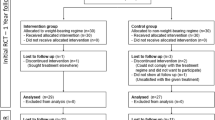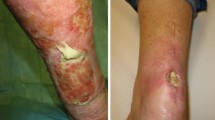Abstract
Purpose
To evaluate ankle function following endoscopically guided percutaneous Achilles tendon repair. The hypothesis of this study was that patients with percutaneous repair of the Achilles tendon would still display impaired involved side ankle proprioception.
Methods
Nineteen male patients with percutaneous Achilles tendon surgery were tested for bilateral ankle active angle reproduction at 10° dorsiflexion and 15° plantar flexion, peak concentric isokinetic ankle dorsiflexor and plantar flexor torque, one-leg hop for distance, and single-leg vertical jump height. Dominant sides of age- and sex-matched 19 healthy controls were evaluated for ankle active angle reproduction at 10° dorsiflexion and 15° plantar flexion, peak concentric isokinetic ankle dorsiflexor and plantar flexor torque.
Results
Peak isokinetic torque, one-leg hop for distance, single-leg vertical jump for height and ankle joint position sense at 10° dorsiflexion did not differ between the affected and unaffected side. Ankle joint position sense for active angle replication at 15° plantar flexion revealed a significant side-to-side difference. Joint position sense at 10° dorsiflexion and at 15° plantar flexion at affected side was poor in patients compared with the controls, while joint position sense at 10° dorsiflexion and at 15° plantar flexion at unaffected side was same in patients compared with the controls.
Conclusions
It has revealed a significant difference in joint position sense at plantar flexion of the patients at least 1 year after percutaneous Achilles tendon surgery compared to their unaffected limb. Large prospective longitudinal studies are needed to evaluate therapeutic interventions designed to improve proprioception.
Level of evidence
III.
Similar content being viewed by others
References
Bolgla LA, Keskula DR (1997) Reliability of lower extremity functional performance tests. J Orthop Sports Phys Ther 26:138–142
Bressel E, Larsen BT, McNair PJ, Cronin J (2004) Ankle joint proprioception and passive mechanical properties of calf muscles after an Achilles tendon rupture: a comparison with matched controls. Clin Biomech 19:284–291
Callaghan MJ, Selfe J, Bagley P, Oldham JA (2002) Effect of patellar taping on knee joint proprioception. J Athl Train 37:19–24
Carmont MR, Maffulli N (2008) Modified percutaneous repair of ruptured Achilles tendon. Knee Surg Sports Traumatol Arthrosc 16:199–203
Cetti R, Henriksen LO, Jacobsen KS (1994) A new treatment of ruptured Achilles tendons: a prospective randomized study. Clin Orthop Relat Res 308:155–165
Doral MN, Bozkurt M, Turhan E, Ayvaz M, Atay OA, Uzumcugil A, Leblebicioglu G, Kaya D, Aydog T (2009) Percutaneous suturing of the ruptured Achilles tendon with endoscopic control. Arch Orthop Trauma Surg 129:1093–1101
Feuerbach JW, Grabiner MD, Koh TJ, Weiker GG (1994) Effect of an ankle orthosis and ankle anesthesia on ankle joint proprioception. Am J Sports Med 22:223–229
Fortis AP, Dimas A, Lamprakis AA (2008) Repair of Achilles tendon rupture under endoscopic control. Arthroscopy 24:683–688
Gigante A, Moschini A, Verdenelli A, Del Torto M, Ulisse S, de Palma L (2008) Open versus percutaneous repair in the treatment of acute Achilles tendon rupture: a randomized prospective study. Knee Surg Sports Traumatol Arthrosc 16:204–209
Goren D, Ayalon M, Nyska M (2005) Isokinetic strength and endurance after percutaneous and open surgical repair of Achilles tendon ruptures. Foot Ankle Int 26:286–290
Gross MT, Everts JR, Roberson SE, Roskin DS, Young KD (1994) Effect of Donjoy ankle ligament protector and Aircast sport-stirrup orthoses on functional performance. J Orthop Sports Phys Ther 19:150–156
Henríquez H, Muñoz R, Carcuro G, Bastías C (2012) Is percutaneous repair better than open repair in acute Achilles tendon rupture? Clin Orthop Relat Res 470:998–1003
Irrgang JJ, Whitney SL, Cox ED (1994) Balance and proprioceptive training for rehabilitation of the lower extremity. J Sport Rehabil 3:68–83
Järvinen TA, Kannus P, Maffulli N, Khan KM (2005) Achilles tendon disorders: etiology and epidemiology. Foot Ankle Clin 10:255–266
Kangas J, Pajala A, Siira P, Hämäläinen M, Leppilahti J (2003) Early functional treatment versus early immobilization in tension of the musculotendinous unit after Achilles rupture repair: a prospective, randomized, clinical study. J Trauma 54:1171–1180
Khan RJ, Fick D, Keogh A, Crawford J, Brammar T, Parker M (2005) Treatment of acute Achilles tendon ruptures: a meta-analysis of randomized, controlled trials. J Bone Jt Surg Am 87:2202–2210
LaRiviere J, Osternig LR (1994) The effect of ice immersion on joint sense position. J Sport Rehabil 3:58–67
Lui TH (2007) Endoscopic-assisted Achilles tendon repair with plantaris tendon augmentation. Arthroscopy 23:556.e1–556.e5
Maffulli N, Tallon C, Wong J, Lim KP, Bleakney R (2003) Early weightbearing and ankle mobilization after open repair of acute midsubstance tears of the Achilles tendon. Am J Sports Med 31:692–700
Maffulli N, Tallon C, Wong J, Peng LK, Bleakney R (2003) No adverse effect of early weight bearing following open repair of acute tears of the Achilles tendon. J Sports Med Phys Fit 43:367–379
Maffulli N (1999) Current concepts review: rupture of the Achilles tendon. J Bone Jt Surg Am 81:1019–1036
Mortensen HM, Skov O, Jensen PE (1999) Early motion of the ankle after operative treatment of a rupture of the Achilles tendon. A prospective, randomized clinical and radiographic study. J Bone Jt Surg Am 81:983–990
Rouvillain JL, Navarre T, Labrada-Blanco O, Garron E, Daoud W (2010) Percutaneous suture of acute Achilles tendon rupture. A study of 60 cases. Acta Orthop Belg 76:237–242
Selfe J, Callaghan M, McHenry A, Richards J, Oldham J (2006) An investigation into the effect of number of trials during proprioceptive testing in patients with patellofemoral pain syndrome. J Orthop Res 24:1218–1224
Simoneau GG, Derr JA, Ulbrecht JS, Becker MB, Cavanagh PR (1996) Diabetic sensory neuropathy effect on ankle joint movement perception. Arch Phys Med Rehabil 77:453–460
Tang KL, Thermann H, Dai G, Chen GX, Guo L, Yang L (2007) Arthroscopically assisted percutaneous repair of fresh closed Achilles tendon rupture by Kessler’s suture. Am J Sports Med 35:589–596
Tenenbaum S, Dreiangel N, Segal A, Herman A, Israeli A, Chechik A (2010) The percutaneous surgical approach for repairing acute Achilles tendon rupture: a comprehensive outcome assessment. J Am Podiatr Med Assoc 100:270–275
Acknowledgments
Authors declare that they have no sponsor in the study design, in the collection, analysis, and interpretation of data; in writing of the manuscript; and in the decision to submit the manuscript for publication.
Conflict of interest
All authors have no conflicts of interest with respect to the data collected and procedures used within this study.
Ethical statement
The authors confirm that this study meets the guidelines of the Declaration of Helsinki, and after local ethical approval, all subjects provided written informed consent. Ethical approval for the study was received from Hacettepe University in Turkey. Number is HEK 11/26-6.
Author information
Authors and Affiliations
Corresponding authors
Rights and permissions
About this article
Cite this article
Kaya, D., Doral, M.N., Nyland, J. et al. Proprioception level after endoscopically guided percutaneous Achilles tendon. Knee Surg Sports Traumatol Arthrosc 21, 1238–1244 (2013). https://doi.org/10.1007/s00167-012-2007-5
Received:
Accepted:
Published:
Issue Date:
DOI: https://doi.org/10.1007/s00167-012-2007-5




